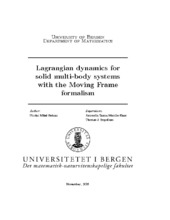Lagrangian dynamics for solid multi-body systems with the Moving Frame formalism
Master thesis
Permanent lenke
https://hdl.handle.net/1956/18756Utgivelsesdato
2018-12-11Metadata
Vis full innførselSamlinger
Sammendrag
Classical mechanics is the study of the motion of particles, solid bodies or of systems of bodies, and the effects of forces and moments on them. The dynamical behavior may either be studied by the application of Newtonian mechanics, Lagrangian mechanics or Hamiltonian Mechanics. Either approach produces mathematical equations describing the time evolution of the multi-body system. The resulting equations of motion for many bodies are typically non-linear and of large scale. The Lagrangian approach is more abstract than the Newtonian approach in the sense that it employs more advanced theory from mathematics, and has therefore traditionally mostly been a topic studied in mathematics, physics or on master level engineering. The Moving Frame Method by H. Murakami et. Impelluso is a formalism which makes advanced results from classical mechanics and group theory available to bachelor level engineers. The method allows engineers without deep understanding of these fields to describe the dynamic behavior of systems that would otherwise be too complex to approach. The method is therefore a framework on which engineers may rely without having a background in group theory or calculus of variations. In this thesis the focus will be on further generalizing the multi-body Moving Frame Method. We will restrict ourselves to multi-body systems with generalized coordinates which are all free rotations. These systems may all be idealized as N-body three-dimensional pendulums (These are sometimes named open kinematic chains). The three main contributions of this thesis is a coordinate free formulation of the Euler-Lagrange equations under the Moving Frame Formalism. An algorithmic approach to generating the equations of motion. The application of quaternions as representation of rotations in numerical simulation of multi-body systems rotating in three dimensions.
